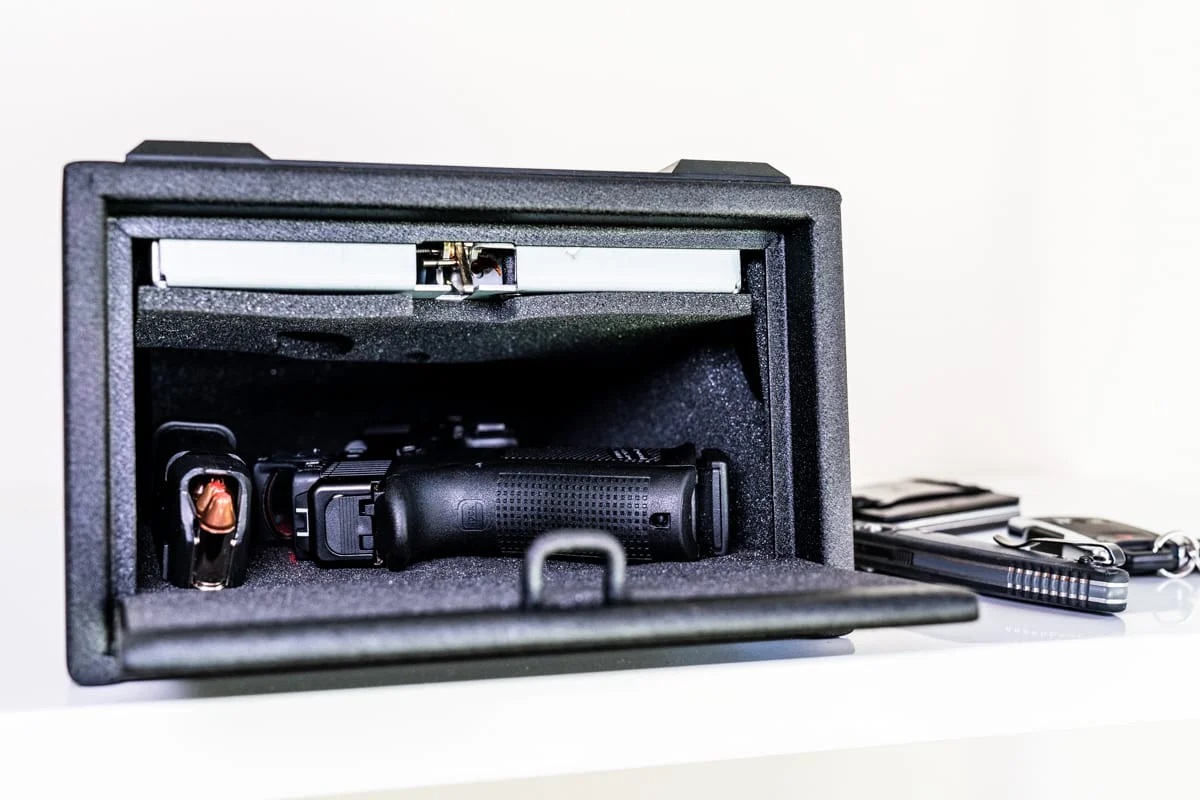

Articles
How To Store Artwork At Home
Modified: January 7, 2024
Learn the best ways to store your artwork at home with these expert articles. Protect and preserve your valuable pieces for years to come.
(Many of the links in this article redirect to a specific reviewed product. Your purchase of these products through affiliate links helps to generate commission for Storables.com, at no extra cost. Learn more)
Introduction:
Artwork adds beauty and personality to our homes. Whether you are an art connoisseur or simply appreciate the beauty of a well-crafted piece, proper storage and care is essential to preserve the quality and longevity of your artwork. When it comes to storing artwork at home, there are several important factors to consider, such as finding the right space, preparing the area, and protecting the artwork from environmental factors.
In this article, we will guide you through the process of storing artwork at home, ensuring that your prized possessions remain safe and in pristine condition. We will explore the best practices for storing both framed and unframed artwork, as well as offer tips for handling, moving, and displaying your pieces. Additionally, we will discuss the importance of insurance and documentation to safeguard your valuable artwork.
By implementing the strategies outlined in this article, you can confidently store and protect your artwork, allowing you to enjoy its beauty for years to come.
Key Takeaways:
- Properly storing and protecting artwork at home involves finding the right space, preparing the area, and implementing proper storage techniques. This ensures the preservation and longevity of your valuable pieces.
- Displaying artwork in your home allows you to appreciate its beauty and showcase your collection. Proper lighting, wall placement, and creating visually pleasing arrangements enhance the aesthetic impact of your artwork.
Read more: How To Store Children’S Artwork
Finding the Right Space:
When it comes to storing artwork at home, finding the right space is crucial. The ideal storage area should be a cool, dry, and well-ventilated space that is not subject to extreme fluctuations in temperature or humidity. Here are some tips to help you find the perfect spot:
- Avoid areas with direct sunlight: Exposure to sunlight can cause the colors in artwork to fade over time. Choose a space that is away from windows or use curtains or blinds to block out the sunlight.
- Consider temperature and humidity: Fluctuations in temperature and humidity can cause the materials in artwork to expand and contract, leading to damage. Aim for a space with a consistent temperature and humidity level, ideally between 65-75 degrees Fahrenheit and 45-55% humidity.
- Keep artwork away from moisture-prone areas: Avoid storing artwork in basements, attics, or areas prone to leaks or high humidity, as moisture can lead to mold and mildew growth.
- Ensure proper ventilation: Good airflow is important to prevent the buildup of moisture and prevent stagnant air. If the storage area is lacking in natural ventilation, consider using a dehumidifier or fan to improve air circulation.
- Consider available wall space: Evaluate the available wall space in relation to the size of your artwork. Ensure that there is enough room to hang or store the pieces without them coming into contact with each other or other objects.
By taking these factors into consideration, you can select a suitable storage space that minimizes the risk of damage to your artwork.
Preparing the Space:
Once you have found the right space to store your artwork, it’s important to properly prepare the area to ensure optimal conditions for preservation. Here are some steps to follow when preparing the storage space:
- Clean the area: Before placing your artwork in the storage space, make sure to clean it thoroughly. Dust and debris can accumulate over time and may harm the artwork. Use a soft cloth or duster to remove any dust from surfaces, shelves, and walls.
- Create a buffer zone: It’s important to create a buffer between the artwork and the walls to prevent any potential damage. You can achieve this by installing a floating shelf or using foam padding strips along the edges of the storage area.
- Use acid-free materials: When storing artwork, it’s essential to use proper archival materials to protect it from acid and other harmful substances. Use acid-free packing paper, cardboard, or archival boxes to wrap and store your artwork.
- Label and organize: Maintain an organized system by labeling your artwork and keeping an inventory of what you have stored. It will make it easier to locate specific pieces when needed and help prevent accidental damage during retrieval.
- Consider climate control: If you live in an area with extreme temperatures or high humidity, it may be beneficial to invest in a climate control system. These systems regulate temperature and humidity, providing a stable environment for your artwork.
By properly preparing the storage space, you can minimize the risk of damage to your artwork and ensure its long-term preservation.
Framed Artwork Storage:
Storing framed artwork requires special care to protect both the frame and the artwork itself. Follow these guidelines to ensure the safe storage of your framed pieces:
- Wrap it in acid-free paper: Before storing framed artwork, wrap it in acid-free archival paper to protect it from dust, moisture, and potential damage. Avoid using plastic wrap, as it can trap moisture and lead to condensation.
- Use protective covers or sleeves: For added protection, consider using archival sleeves or glassine covers to further shield the artwork and prevent any potential scratches or damage.
- Avoid hanging artwork directly on walls: When storing framed artwork, it’s best to avoid hanging it directly on the walls. Instead, place it on shelves or use storage racks that provide sufficient support and prevent any pressure on the frame.
- Stack framed artwork vertically: If you need to store multiple framed pieces, stack them vertically with appropriate padding in between. This will help minimize the risk of accidental damage due to shifts or falls.
- Maintain proper spacing: Ensure there is enough space between each piece of framed artwork to prevent any potential damage from rubbing or scratching against each other. Use foam padding or acid-free cardboard to create a protective barrier between frames.
- Avoid areas prone to moisture: Keep framed artwork away from areas that are susceptible to dampness or humidity, as moisture can cause damage to both the frame and the artwork. Consider using moisture-absorbing packets or a dehumidifier to maintain optimal conditions.
By following these guidelines, you can ensure that your framed artwork remains protected and in excellent condition while in storage.
Unframed Artwork Storage:
Storing unframed artwork requires extra care to protect the delicate surfaces and prevent any damage. Here are some guidelines to follow when storing unframed artwork:
- Use acid-free materials: Start by using acid-free archival paper or glassine to wrap each individual piece of unframed artwork. This will provide a protective barrier against dust, moisture, and potential scratches.
- Flat storage: Store unframed artwork flat to prevent any warping or bending. Choose a rigid and sturdy surface, such as acid-free foam boards or archival boxes, to support the artwork from underneath.
- Protective sleeves: If the artwork is smaller in size, consider placing it in archival sleeves or clear plastic sleeves for added protection. Be sure to use sleeves that are specifically designed for artwork, as regular plastic sleeves may trap moisture and damage the artwork.
- Separate with acid-free dividers: When storing multiple unframed artworks together, place acid-free dividers between each piece to prevent them from coming into direct contact with each other. This will help avoid any potential rubbing or scratching.
- Consider portfolios or flat storage boxes: For larger collections or oversized pieces, consider using portfolios or flat storage boxes made specifically for storing artwork. These provide additional protection and make it easier to transport and access the pieces when needed.
- Avoid areas with high humidity: Keep unframed artwork away from areas with high humidity, such as basements or bathrooms. Humidity can cause the paper to warp or become moldy. Opt for a cool, dry, and well-ventilated storage space.
By following these guidelines, you can ensure that your unframed artwork remains in excellent condition and is protected from any potential damage while in storage.
When storing artwork at home, avoid hanging it in direct sunlight or near heat sources to prevent fading or damage. Instead, store it in a cool, dry place away from any potential hazards.
Read more: How To Store Artwork
Protecting Artwork from Environmental Factors:
Artwork is vulnerable to various environmental factors that can cause damage over time. To safeguard your artwork, it’s important to take precautions and protect it from these factors:
- Temperature and humidity: Maintain a stable environment for your artwork by keeping it away from areas with extreme temperature fluctuations and high humidity. Drastic changes in temperature and humidity can lead to warping, cracking, and mold growth. Aim for a cool, dry, and well-ventilated storage space.
- Light exposure: Limit exposure to direct sunlight and harsh artificial lighting, as it can cause fading and discoloration of artwork over time. Choose a storage space away from windows or use UV-filtering coatings or curtains to protect your pieces from harmful UV rays.
- Harmful gases and pollutants: Avoid storing artwork near sources of gas or chemicals, as they can emit harmful gases that can deteriorate the materials. Keep your artwork away from areas with potential exposure to smoke, fumes, or cleaning products.
- Pests and insects: Protect artwork from potential damage caused by pests and insects by regularly inspecting the storage area and using preventive measures such as traps or repellents. Avoid storing artwork in areas prone to infestations, such as basements or attics.
- Mold and mildew: To prevent mold and mildew growth, ensure that the storage space is dry and well-ventilated. Monitor humidity levels regularly and consider using dehumidifiers or moisture-absorbing packets to maintain optimal conditions.
- Handling with care: When handling artwork, make sure your hands are clean and dry to avoid transferring oils and dirt onto the surface. Use white cotton gloves when necessary to prevent direct contact with delicate materials.
By being aware of these environmental factors and taking the necessary precautions, you can protect your artwork from potential damage and ensure its long-term preservation.
Handling and Moving Artwork:
Proper handling and careful movement of artwork is essential to prevent accidental damage. Whether you’re repositioning, transporting, or storing artwork, here are some guidelines to follow:
- Handle with clean hands: Always ensure your hands are clean and dry before touching artwork. Oils, dirt, and moisture can transfer onto the surface and cause damage over time. If necessary, wear white cotton gloves to minimize direct contact.
- Support the artwork: When picking up and carrying artwork, provide support to the entire piece. Avoid gripping or holding it by the frame or edges, as this can cause stress and potential damage. Instead, support the artwork from underneath using both hands.
- Use protective coverings: For added protection during transportation or temporary storage, consider using acid-free cardboard corners or foam padding to shield the corners of framed artwork. This helps prevent any accidental bumps or scratches.
- Secure artwork in transit: If you’re transporting artwork, make sure it is securely fastened and protected in a properly sized and padded box or crate. Use packing materials such as bubble wrap or foam inserts to prevent any movement and absorb any potential shocks.
- Be cautious with large and heavy pieces: When handling large or heavy artwork, it’s important to have assistance to avoid straining yourself or causing damage. Use tools such as dollies or carts to safely move larger pieces.
- Consider professional assistance: For especially valuable or delicate artwork, it may be worth considering the services of professional art handlers or movers who have expertise and experience in safely transporting and handling artwork.
By following these guidelines, you can minimize the risk of accidental damage and ensure safe handling and transportation of your artwork.
Displaying Artwork at Home:
Displaying artwork in your home allows you to showcase your collection and enjoy its beauty. Here are some tips to consider when displaying artwork:
- Choose the right location: Select a suitable wall or space that complements the artwork and enhances its visual impact. Consider factors such as lighting, room aesthetics, and the size and style of the piece.
- Properly hang framed artwork: Use appropriate picture hanging hooks or wall anchors to securely mount framed artwork on the wall. Ensure the artwork is level and properly centered. Use a level and measuring tape for accuracy.
- Create an art gallery wall: If you have multiple pieces to display, consider creating a gallery wall. Arrange the artwork in a visually appealing layout, with a mix of different sizes, shapes, and styles. Use templates or painters tape to plan the arrangement before hanging.
- Consider lighting: Proper lighting can enhance the visibility and showcase the details of your artwork. Use adjustable track lighting or picture lights to highlight specific pieces. Avoid direct sunlight, as it can cause fading and damage the artwork.
- Rotate your collection: To prevent overexposure to light and reduce potential damage, consider rotating your artwork periodically. This allows you to enjoy different pieces while ensuring their long-term preservation.
- Use shelves or display cases: Certain types of artwork, such as sculptures or delicate objects, may be better suited for display on shelves or within glass display cases. This provides protection while allowing for easy viewing.
- Consider environmental factors: Ensure that the area where you display your artwork is not subject to extreme temperature fluctuations, high humidity, or excessive exposure to dust or pollutants. Create a suitable environment for your precious pieces.
- Showcase your personal style: Display artwork in a way that reflects your personal style and complements your overall home decor. Experiment with different arrangements and combinations to create a space that is visually pleasing and meaningful to you.
By following these tips, you can create a visually captivating and personalized display of artwork in your home.
Insurance and Documentation:
Protecting your artwork goes beyond proper storage and display. It’s crucial to have insurance coverage and proper documentation to safeguard your collection. Here are some important steps to consider:
- Artwork appraisal: Have your artwork appraised by a qualified professional to determine its value. This valuation serves as an essential reference for insurance purposes and can help justify a claim if needed.
- Insurance coverage: Consult with an insurance agent specializing in art insurance to understand your options. Consider obtaining specific art insurance or extending your existing homeowner’s insurance to cover your artwork collection.
- Document your collection: Create a detailed inventory of your artwork, including descriptions, artist names, dimensions, photographs, purchase receipts, and appraisals. Store this information in a secure location, both physically and digitally.
- Update appraisals and documentation: Regularly update your artwork appraisals and document any changes in value, acquisitions, or sales. This ensures that your insurance coverage accurately reflects the current value of your collection.
- Proper handling and transportation records: Keep records of any instances when the artwork is moved, loaned, or transferred to another location. This documentation can be valuable for insurance claims and maintaining the history of your collection.
- Secure storage and display: Insurance companies may have specific requirements for artwork storage and display to ensure coverage. Follow their guidelines regarding security systems, fire protection, and environmental controls to maintain coverage.
- Regularly review and update your policy: Review your insurance policy annually to ensure it still meets your needs. Consider any new acquisitions or changes to your collection and adjust your coverage accordingly.
- Stay informed: Keep up-to-date with the latest trends and changes in the art market. This knowledge can guide you in assessing the value of your artwork and making informed decisions about insurance coverage.
By having proper insurance coverage and well-documented records, you can have peace of mind knowing that your artwork is protected financially, and you have evidence of its provenance and value.
Read more: How To Store Artwork
Conclusion:
Storing and protecting artwork at home requires careful consideration and attention to detail. By following the guidelines outlined in this article, you can ensure that your artwork remains safe, preserved, and enjoyed for years to come.
Finding the right space, preparing the area, and implementing proper storage techniques are essential to maintaining the condition of your artwork. Whether you are storing framed or unframed pieces, using acid-free materials, maintaining optimal environmental conditions, and handling artwork with care are key aspects to consider.
Displaying artwork in your home allows you to appreciate its beauty and showcase your collection. Proper lighting, appropriate wall placement, and creating a visually pleasing arrangement add to the overall aesthetic impact of your artwork.
Insurance coverage and documentation are crucial steps to protect your valuable artwork. By maintaining up-to-date appraisals, documenting your collection, and having proper insurance coverage, you can safeguard your investment and have peace of mind in the event of any unforeseen circumstances.
Remember to regularly review and update your storage methods, insurance policies, and documentation to keep them up-to-date and in line with the changing needs of your artwork collection.
By following these best practices and ensuring the proper care and protection of your artwork, you can preserve its beauty, value, and significance for future generations to enjoy.
Frequently Asked Questions about How To Store Artwork At Home
Was this page helpful?
At Storables.com, we guarantee accurate and reliable information. Our content, validated by Expert Board Contributors, is crafted following stringent Editorial Policies. We're committed to providing you with well-researched, expert-backed insights for all your informational needs.














0 thoughts on “How To Store Artwork At Home”